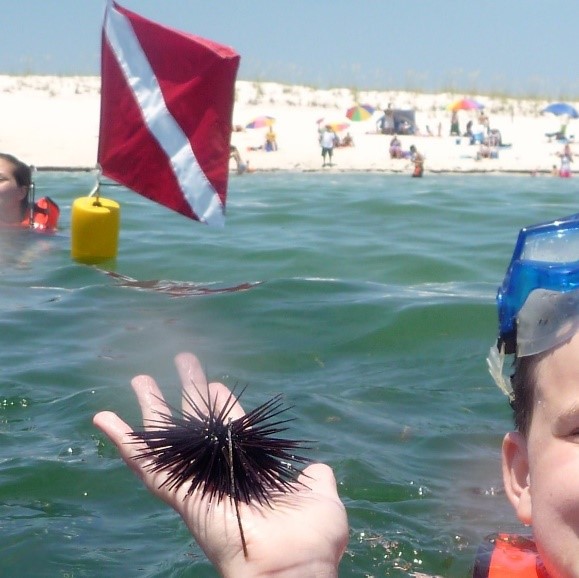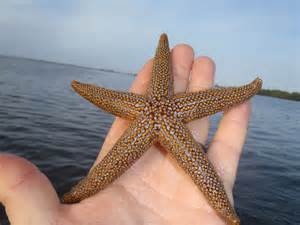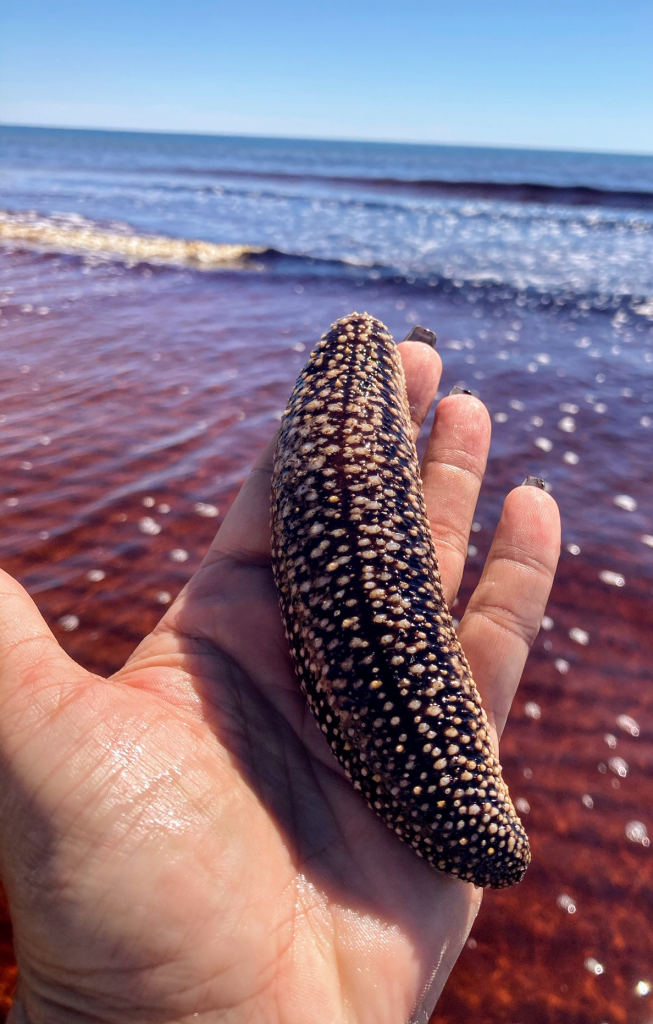Sea urchins are one of the more commonly encountered creatures when snorkeling in our seagrass beds. At times these little pin cushions can be found in great numbers. In some locations there have been too many and community events have been developed to remove some. In the western panhandle they have all but disappeared. But for many parts of the panhandle, they are a noticeable member of the seagrass community.

Sea urchins belong to the phylum Echinodermata. The term echinoderm means “spiny skin” and is a good name for this creature. This group also includes the sand dollars, sea cucumbers, and the most famous member, the sea stars. Echinoderms are considered advanced and primitive at the same time. Advanced in the sense of organ development, sensory perception, and food gathering. Primitive in the sense that they have radial symmetry, like many of the more primitive invertebrate groups; bilateral symmetry is considered more advanced. The entire phylum is marine, they have no freshwater, nor terrestrial members, and they do like the water salty – at least 20 parts per thousand, and some need it higher than that.
As mentioned, the sea stars are the “star” of the group. They usually have five arms that radiate from a central disk region. On top there are usually small knobs or bumps which are the remnants of their “spiny skin”. Some species, though none in our area, have elongated spines. Beneath the arms is a radial canal which houses a series of gelatinous suckers called tube feet. The sea star can fill these with water using a unique system called the water vascular system. The tips of the tube feet or concave and, when full of water, can create a suction cup that is used for pulling themselves along the bottom and for grabbing food. These canals all meet within the central disk in what is called a ring canal and the water that fills them is sucked in by the sea star through a screen-like structure on the top of the central disk called a madreporite (“screen sieve”). The central disk is where the mouth is located, and it is located on the bottom. Food is worked into the mouth, digested, and excreted through an anus on the top of the central disk. Most species have some form of eye at the end of each arm and have a good sense of smell and taste.
Sea stars are predators, collecting small organisms they are fast enough to catch (which is not many really). But they can also take on larger slow prey, like shellfish. When they approach an oyster, which is sessile and cannot run away, they will grab each of the valves (shells) of the oyster with one of their arms. They will draw water into their water vascular system creating suction on the tube feet and “stick” onto the shells. They will then force the oyster open. Once open they will invert their digestive tract out of their body in a process called evisceration, consume the oyster, then retract the digestive tract leaving two empty shells on the seagrass bed floor. These empty shells are often found by snorkelers – though there are other predators of bivalves.

Sea urchins differ from their sea star cousins in the way their body is laid out. Imagine you had a five-armed sea star laying on the ocean floor. Imagine taking each of the five arms and rolling them upwards so that the tips of each touch above the central disk. Can you imagine this looking like a ball? A sphere? Now cover the now exposed underside of the arms with long spines (quills) and the tube feet extend between the quills. You have a sea urchin.
Another difference would be the mouth. At the terminus of each arm near the mouth is a single tooth. With five arms, there would be five teeth. Scientists call this set of five teeth Aristotle’s lantern and the urchin uses this to scrap algae from rocks, shells, and grass blades. They are herbivores, moving along feeding on a variety of seaweed and seagrasses in the system.
There is concern with many snorkelers that the quills (spines) of the sea urchin are venomous. That is the case with some species around the world, but not in our area. That said, they are sharp, and the purple urchin (more common in our rock jetties and artificial reefs) hurts. Their quills are sharp and often break off in the skin causing discomfort, much like a splinter. You do not want to handle them, but if you do – handle them with care.
Sand dollars are close cousins of the sea urchin and are in the same class (Echinoidea). If you can imagine taking a round sea urchin and squashing it flat like a pancake, you have a sand dollar. There are also echinoderms in this group that are not as round as sea urchins, but not as flat as sand dollars and are called heart urchins, or sea biscuits. These can be found in grassbeds at the eastern end of the panhandle, but are more common in south Florida.
The sea cucumber is an echinoderm more often found in rocky or coral reef communities, but there are some found in the seagrass beds. To see the relationship between them and their cousins, imagine taking a round sea urchin, lie it on its side, and extended the body so that it is no longer a round ball but an elongated worm-looking creature… sea cucumber. These are primarily scavengers and deposit feeders within the community.

Being a resident of the western panhandle, we have noticed a mass decline of echinoderms in our grassbeds. As a kid in the 60s and 70s we never saw large numbers, as they do in the eastern panhandle, but we did see them. Now they are gone. One suggestion as to why has been salinity. Our bay system over here has more river discharge than those further east and the lower salinity may not support larger populations. The increased development of the years, and the methods of dealing with stormwater, may have created a system that echinoderms do not like. Whatever the reason, finding sea stars and sea urchins in our grassbeds is rare.
The eastern panhandle still has them. And, at times, too many. In recent years there has been an increase in sea urchin populations in St. Joe Bay that has led to overgrazing of the turtle grass. This could lead to a decline in suitable habitat for bay scallops, which the community depends on economically. The state currently sponsors a “Sea Urchin Round Up” event using humans to help control the overabundance of sea urchins.
Echinoderms are a visible, and interesting, part of our seagrass community.
- Our Environment: Part 11 – We Need Water - July 7, 2025
- Our Environment: Part 10 – Improving Agriculture - June 20, 2025
- Marine Creatures of the Northern Gulf – Snails and Slugs - June 20, 2025
